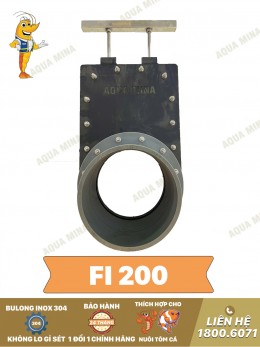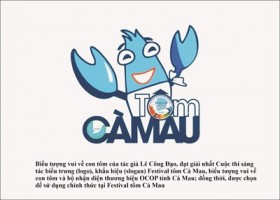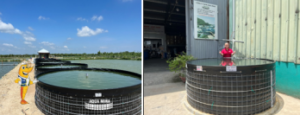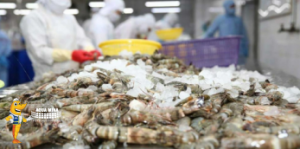Sharing How to Identify High-Quality Shrimp Seed
1. Traceability: When selecting shrimp seed for farming, it is essential to know the origins, farming process, and feed used.

- Parent Stock Origins:
+ For Black Tiger Shrimp: Originating from wild sea shrimp or imported sources like Moana and African shrimp, weighing 120 – 150 g. Preference is given to naturally mature broodstock, while repeated breeding from molted or artificially inseminated shrimp should be minimized.
+ For Whiteleg Shrimp: Parent shrimp must originate from Hawaii, and they are farmed and bred for no more than four months from the time they are brought to the hatchery. Note that the first and second spawning cycles yield better quality seeds, while the third cycle often produces shrimp that grow slower and are of lower quality.
- Farming Process: From the day the shrimp are spawned to the PL12 stage (when they reach a size of 1.1 – 1.2 cm), the average growth period should be 22–25 days for normal development, though it may take longer. It is preferable to choose farming methods that limit the use of antibiotics and chemicals for disease prevention and treatment.
- Feed: Priority is given to shrimp seed that are fed with fresh algae, live feed such as rotifers, copepods, and artemia. Feed for larvae should be high-quality and from reputable brands.
2. PCR Testing
Before purchasing shrimp seed, farmers should conduct PCR tests to avoid purchasing shrimp infected with dangerous viruses such as white spot syndrome virus (WSSV), yellow head virus (YHV), infectious myonecrosis virus (IMNV), Taura syndrome virus, and acute hepatopancreatic necrosis disease (AHPND).
3. Physical Inspection
- Healthy shrimp seed can be identified by observing certain characteristics: vibrant and uniform coloration, well-defined pigmentation, balanced head and body, neatly aligned antennae, slender abdomen segments, and a taut, filled flesh-to-shell ratio. Appendages should be intact, with active, consistent feeding in the intestines.
- Shrimp seed should respond actively to external stimuli, be evenly distributed in tanks, swim upright, and show a tendency to swim against currents and cling well to tank walls.
- Shrimp should show no signs of luminous bacteria under dark conditions in tanks. Sizes should be uniform, with a size deviation of no more than 5%; PL15 (12 mm) for Black Tiger shrimp and a minimum of PL12 (9 – 11 mm) for Whiteleg shrimp is preferred.
4. Microscopic Examination
- Many features are not visible to the naked eye, so it’s important to examine the shrimp seed under a microscope to check for parasites, fungal infections, or injuries to body parts like antennae, legs, and abdomen.
- A healthy shrimp displays pigment cells in the abdominal area in small star-shaped spots, a large hepatopancreas with many lipid droplets, and a muscular thickness four times the gut diameter in the abdomen. The gut should be full, and shrimp should be free from fungi, protozoan parasites, and attachments on legs, abdomen, tail, shell, and gills.
- Healthy shrimp have complete appendages, while weak shrimp have a smaller hepatopancreas, a pale color, few lipid droplets, and pigment cells that extend in lines across the abdomen.
5. Stress Testing
- After identifying quality shrimp seed, it’s essential to perform a stress test to eliminate weak shrimp before introducing them to grow-out ponds.
- The stress test (stress test) is a popular and effective method for selecting strong shrimp among farmers. This can be done by abruptly reducing salinity or using formaldehyde. Stress testing helps assess the shrimp's resilience and overall health, helping prevent disease risk during farming.

Stress Testing Methods:
- Formaldehyde Test: Place 100 – 200 shrimp seed in a glass container with a 100 ppm formalin solution. Monitor for 30 minutes; a mortality rate of less than 5% is acceptable.
- Salinity Test: Place 100 shrimp seed in a bucket with 2 liters of farming water, then add 3 liters of freshwater to suddenly reduce salinity. After 2 hours, a survival rate of over 95% is considered satisfactory.
A successful shrimp farming process combines high-quality shrimp seed with excellent farming techniques and nutritious feed. However, without a stable pond environment, success is challenging. A well-maintained pond environment includes a covered, technology-integrated mobile nursery pond, which helps stabilize water quality and minimizes disease risk. Healthy shrimp stock in these nurseries can adapt to surrounding environments before being introduced to grow-out ponds. AQUA MINA is ready to assist you in creating the ideal farming process with our mobile nursery pond technology. Message us with “consult for nursery pond,” and we’ll get back to you with a free consultation.
Contact AQUA MINA for consultation and supply of aquaculture round tanks and aquaculture equipment for high-tech shrimp farming.
- Address: 685 National Highway 1A, Binh Hung Hoa Ward, Binh Tan District, Ho Chi Minh City
- Phone: 1800 6071 (Toll-free hotline)
- Email: sales@aquamina.com.vn or oversea@aquamina.com.vn
Aqua Mina's distributor in Japan:
REX INDUSTRIES CO., LTD
- Address: 1-9-3 Hishiya-Higashi, Higashi-Osaka 578-0948 JAPAN
- Email: kimakubo@rexind.co.jp
- Phone: +81-(0)72-961-9893
- Website: http://www.rexind.co.jp/e/

WE WORK FOR YOUR SUCCESS
Ngày đăng : 05/11/2024
2115 View
Other Articles
Vietnamese shrimp and catfish choose a sustainable path in global competition
End-of-Season Shrimp Prices Reach Record Highs
Norway – Russia Reach Barents Sea Fisheries Agreement for 2026
Cà Mau strengthens traceability to enhance the competitiveness of the shrimp industry.
Cold stress: Effects on the plasma characteristics of whiteleg shrimp.
A new breakthrough in the prevention of diseases caused by the microsporidian parasite EHP in shrimp farming
Vietnam’s shrimp export outlook in the first quarter of 2026 continues to face heavy pressure from tariffs.
New England’s shrimp fishery to shut down for the long haul after years of decline
Crab exports to the United States account for more than 80%.
Thailand sets a target to increase shrimp production to 400,000 tons by 2026.
CTU-RAS: Recirculating Shrimp Farming for Sustainable Development
Vietnamese aquatic products reach new markets



















.jpg)